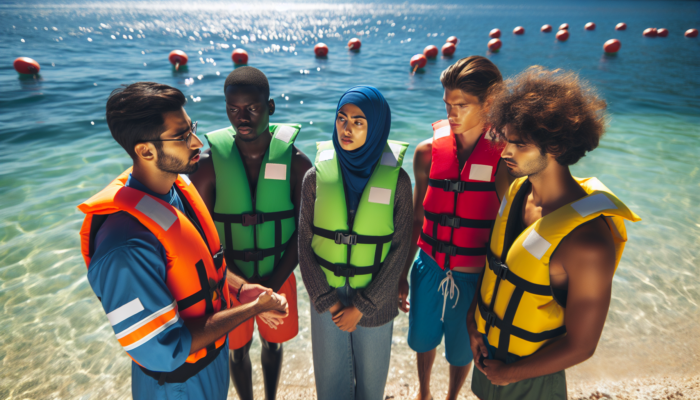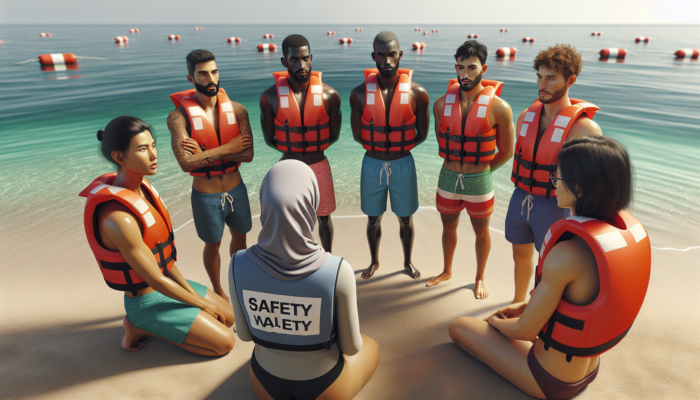Evaluate Water Hazards to Ensure Safe and Enjoyable Aquatic Activities

Participating in water-related activities not only provides immense enjoyment but also offers a great way to relax and unwind. However, it is crucial to recognize and thoroughly understand the various risks associated with these activities. By gaining insights into the potential dangers that can arise in diverse aquatic environments—ranging from swimming pools to vast open waters—individuals can engage in safer swimming experiences. This heightened awareness empowers water enthusiasts to take proactive measures to mitigate risks, thus creating a more enjoyable and safer atmosphere for everyone involved in aquatic recreation.
Recognizing Common Water Hazards to Enhance Safety Awareness
The risks associated with various water environments are multifaceted and can differ significantly depending on the specific location. In swimming pools, common hazards include slips and falls, diving-related accidents, and other incidents that may lead to severe injuries. Additionally, chemicals found in pool water introduce further risks; improper handling of these substances can result in chemical burns or respiratory complications. Conversely, open water locations present unique challenges such as strong currents, unpredictable tides, and potentially dangerous aquatic life, all of which can create hazardous conditions for swimmers. Understanding these potential hazards is essential for improving overall safety awareness.
To prepare effectively for safe swimming experiences, individuals should actively educate themselves about the specific characteristics of the aquatic environment they plan to enjoy. For instance, recognizing that lakes and rivers may conceal dangerous rocks, sudden changes in depth, or submerged debris is crucial for ensuring safety. This knowledge equips swimmers to exercise caution and make informed decisions, significantly decreasing the chances of accidents during their aquatic adventures. Being prepared means knowing what to expect and planning accordingly.
Furthermore, awareness of environmental conditions plays a pivotal role in water safety. Fluctuations in weather and water temperature can greatly affect overall safety. Cold water has the potential to incapacitate even the most skilled swimmers, while storms and high winds can create treacherous situations. Being mindful of these elements allows individuals to assess risks accurately and select the most appropriate times and locations for swimming activities, thereby ensuring a safer experience.
Conducting a Comprehensive Risk Assessment for Safer Swimming Practices
Assessing the safety of a swimming area involves a meticulous evaluation of multiple factors, including water depth, current strength, and visibility. A comprehensive understanding of these elements can significantly improve overall safety. For example, when swimming in the ocean, it is essential to carefully scrutinize wave intensity and current conditions, as powerful undertows can pose severe dangers, even to experienced swimmers. Recognizing these factors can be the difference between a safe outing and a potentially life-threatening situation.
Water depth is a fundamental component of this evaluation. Shallow areas can lead to injuries from diving or jumping, while deeper waters may conceal sudden drops or unpredictable currents. Visibility remains equally important; murky or unclear waters can obscure hazards and hinder the ability to locate swimmers in distress, thereby increasing the likelihood of accidents. Ensuring that swimmers can see the conditions they are entering is paramount for their safety.
Before entering any body of water, individuals are strongly encouraged to conduct a personal risk assessment. This involves identifying designated swimming areas and paying attention to warning signs. Gaining a solid understanding of local water conditions, including temperature fluctuations, tide schedules, and advisories from local authorities, is vital for ensuring a safe swimming experience. Knowledge is power, and being informed can lead to safer aquatic adventures.
Implementing Effective Strategies to Prevent Water-Related Accidents

Preventing accidents in aquatic environments is crucial and can be achieved through a variety of strategies. One of the most effective measures is ensuring that lifeguards are present in public swimming areas. These trained professionals can respond promptly to emergencies, making their presence invaluable in minimizing the risk of drowning and other incidents that could result in serious injuries or loss of life. Their vigilance can provide peace of mind to swimmers and their families.
Safety barriers also play a significant role in water safety practices. For instance, fencing around swimming pools can prevent unsupervised access, especially for young children who are at a heightened risk. In addition, clear warning signs and easily accessible flotation devices can enhance safety in open water areas, alerting swimmers to potential hazards and providing essential tools for self-rescue in emergencies. Ensuring that safety measures are visible and accessible can make all the difference.
Beyond physical barriers, educating swimmers about safe practices is vital for promoting water safety awareness. Informing individuals about the importance of swimming with a buddy, understanding personal limitations, and recognizing potentially hazardous conditions can significantly improve safety outcomes. Establishing a culture of accountability among swimmers ensures that everyone prioritizes safety, making water activities more enjoyable and secure for all participants. The more informed the swimmers are, the safer they will be.
Developing Key Swimming Skills and Techniques for Enhanced Safety
Acquiring fundamental swimming skills is not only essential for enhancing enjoyment but also serves as a critical component of ensuring personal safety in aquatic environments. A well-rounded set of swimming techniques enables individuals to navigate various situations effectively, boosting their confidence and maximizing their enjoyment of water-related activities. Being well-prepared can make a significant difference in emergency situations.
Mastering Essential Swimming Strokes for Greater Efficiency
Mastering foundational swimming strokes, such as freestyle and breaststroke, is vital for effective movement in the water. Freestyle, known for its speed and efficiency, allows swimmers to cover distances quickly while maintaining control. Regular practice of this stroke enhances cardiovascular endurance and strengthens upper body muscles, significantly contributing to overall fitness and proficiency in the water. This stroke is often the most useful in competitive settings.
On the other hand, breaststroke is an important technique that emphasizes breath control and timing. This stroke is particularly beneficial for beginners, as it allows for a comfortable pace and fosters a feeling of security in the water. Understanding the mechanics behind both strokes aids swimmers in developing their skills and adapting to various swimming environments, whether they are in pools or open waters. Recognizing the strengths of each stroke can empower swimmers to choose the best technique for their needs.
Learning these basic strokes also nurtures confidence, encouraging swimmers to explore more challenging environments. With consistent practice and dedication, individuals can enhance their proficiency, ensuring they are well-prepared for emergencies and capable of safely enjoying a wide range of aquatic activities. Developing these skills is a crucial step toward becoming a competent and confident swimmer.
Acquiring Essential Survival Swimming Techniques for Enhanced Safety

Mastering essential survival swimming techniques, such as floating and treading water, is vital for saving lives in unexpected situations. Proficient floating techniques enable individuals to conserve energy while remaining buoyant, offering crucial time for rescue or an opportunity to reassess their surroundings and plan their next steps. This skill can be lifesaving in an emergency.
Treading water represents another essential survival skill. This technique involves a combination of arm and leg movements that allow a person to stay afloat using minimal energy. Regular practice of treading water not only enhances endurance but also prepares individuals for scenarios where they may need to remain afloat for extended periods, such as in open water or during emergencies. Building this endurance is a key aspect of safety.
Integrating survival swimming techniques into regular training routines benefits swimmers of all skill levels. Whether in a pool, lake, or the sea, these critical survival skills promote confidence and contribute to a safer swimming experience for everyone involved. Emphasizing these techniques can help ensure that swimmers are better prepared for any unforeseen circumstances.
Exploring Advanced Swimming Techniques for Competitive Excellence
Advanced swimming techniques, such as flip turns and underwater dolphin kicks, can significantly benefit those eager to elevate their swimming capabilities. Flip turns facilitate efficient transitions when swimming laps, enhancing speed and minimizing the time spent at the wall during competitive events. Mastering this technique enables swimmers to maintain momentum and improve overall performance, making it a crucial skill for competitive swimmers.
Underwater dolphin kicks are equally advantageous, particularly in competitive swimming. This technique requires swimmers to adopt a streamlined position while employing rhythmic movements that propel them efficiently through the water. Regular practice of these advanced techniques can greatly enhance a swimmer's ability to navigate challenging conditions, making them more adaptable to various aquatic environments. These skills are essential for those looking to compete at higher levels.
Engaging in advanced training not only hones swimming skills but also boosts overall fitness levels, promoting cardiovascular health and muscle strength. As swimmers become more skilled, they gain the confidence necessary to tackle different water conditions and participate in a broader range of aquatic activities, enriching their enjoyment and safety. This level of preparedness can lead to more fulfilling swimming experiences.
Building Endurance and Fitness through Targeted Swimming Drills
Developing stamina through targeted swimming drills and exercises is crucial for long-distance swimming and overall health. Regular swimming workouts can substantially enhance cardiovascular endurance, enabling swimmers to tackle challenging distances with greater ease. Incorporating interval training, where swimmers alternate between high-intensity sprints and recovery periods, aids in building endurance while concurrently improving speed and efficiency in the water. This approach can lead to significant performance improvements.
In addition to formal training sessions, integrating fitness exercises both in and out of the water can further enhance swimming performance. Strength training focusing on core muscles, arms, and legs builds the necessary muscle groups for effective swimming strokes. Improved overall fitness not only contributes to enhanced swimming but also promotes general health and well-being. A comprehensive fitness regimen can lead to better swimming outcomes.
Moreover, setting specific fitness goals and tracking progress can motivate swimmers to push their limits. Whether training for a competition or aiming for personal fitness milestones, embracing a comprehensive approach to swimming and fitness encourages a healthier lifestyle and fosters a lifelong love for water activities. This commitment to fitness can make swimming even more enjoyable and rewarding.
Crucial Safety Equipment and Gear for Optimal Swimming Experiences
Having the appropriate safety equipment and gear is essential for ensuring a secure swimming experience. From life jackets to personal safety devices, understanding the various tools available can significantly enhance safety in and around water. The right gear can make all the difference in emergency situations.
The Essential Role of Life Jackets in Water Safety
Wearing properly fitted life jackets is crucial, especially in open water or boating scenarios. Life jackets provide vital buoyancy, acting as a lifeline for individuals who may find themselves in distress. Selecting a life jacket that adheres to relevant safety standards and is suitable for the individual's size and weight is imperative for ensuring maximum safety. This precaution can prevent drowning incidents.
Before engaging in any water-related activities, individuals should ensure that everyone in their group is equipped with life jackets, particularly children and inexperienced swimmers. Properly wearing and adjusting life jackets guarantees optimal safety and functionality. Regular inspections of life jackets for wear and tear ensure they remain reliable and ready for use whenever needed. This diligence is a key component of water safety.
Promoting the significance of life jacket usage within the community contributes to a culture of safety. Engaging in awareness campaigns and emphasizing the necessity of life jackets during boating or swimming in open waters establishes a proactive approach to water safety. The more informed the community is, the safer they will be.
Understanding Rescue Equipment for Efficient Emergency Responses
Familiarizing oneself with rescue equipment, such as life rings and throw ropes, is pivotal for facilitating emergency water rescues. Life rings are designed for easy throwing to distressed swimmers, providing immediate flotation assistance until help arrives. Understanding how to deploy rescue equipment effectively ensures a more efficient emergency response, potentially saving lives in critical situations. This knowledge can be lifesaving.
Throw ropes offer another layer of safety, allowing rescuers to reach individuals in distress without entering the water themselves. Knowing how to use throw ropes effectively, including proper handling and throwing techniques, can significantly enhance rescue efforts. Practicing these skills in controlled environments prepares individuals for real-life scenarios, ensuring they can act quickly and effectively in emergencies. Preparedness is crucial in these situations.
Integrating knowledge of rescue equipment into water safety education initiatives fosters a more informed community. Encouraging awareness of available resources enhances collective safety, ensuring that everyone is prepared to act in emergencies when necessary. This proactive approach can lead to better outcomes in critical situations.
Utilizing Personal Safety Devices for Enhanced Comfort and Protection
Additional gear, such as swim goggles and earplugs, can greatly enhance both comfort and safety in the water. Swim goggles protect the eyes from irritation caused by chlorine and improve visibility while swimming. Exploring different types of goggles enables swimmers to find a pair that suits their preferences and enhances their overall experience in the water. The right equipment can significantly improve comfort while swimming.
Earplugs are equally beneficial, particularly for individuals prone to ear infections or discomfort while swimming. Effective earplugs help prevent water from entering the ears, reducing the risk of conditions such as swimmer's ear. Understanding the various personal safety devices available empowers swimmers to make informed choices that enhance their enjoyment and safety in aquatic environments. Comfort is an important aspect of safety in the water.
Investing in quality personal safety devices and promoting their use within the community fosters a culture of safety. By prioritizing comfort and protection, swimmers are more likely to engage in water activities regularly, contributing to their overall well-being and enjoyment. This helps ensure a safer and more enjoyable swimming experience.
The Vital Role of Safety Whistles in Emergencies
Safety whistles can be invaluable for signaling distress and attracting attention during water emergencies. Carrying a whistle while swimming, especially in open waters, can greatly enhance a swimmer's chances of being located quickly. In emergencies, the sound of a whistle travels much farther than a person's voice, making it an essential tool for safety. This simple device can prove to be lifesaving.
Understanding how to use safety whistles effectively is crucial. Swimmers should be encouraged to blow the whistle in a series of short bursts, as rescuers are more likely to recognize this pattern. Additionally, familiarizing oneself with safety protocols, such as where and how to call for help, can significantly enhance emergency response times. Being prepared can greatly impact outcomes in emergencies.
Promoting the use of safety whistles within swimming communities fosters better preparedness and awareness. Establishing a culture where swimmers are equipped with essential safety equipment helps create safer aquatic environments for everyone involved. This commitment to safety is vital for ensuring enjoyable and secure swimming experiences.
The Importance of Supervision and Responsibilities in Ensuring Water Safety
Ensuring constant supervision is fundamental to water safety, particularly for children. The responsibility of adults and caregivers in monitoring water activities cannot be overstated, as their vigilance can prevent many accidents and save lives in critical situations. A proactive approach to supervision is essential for maintaining safety.
The Impact of Adult Supervision on Water Safety
Constant adult supervision of children in and around water is crucial for preventing accidents. Adults should always remain vigilant and be prepared to respond quickly to any emergencies that may arise. Establishing designated watch areas ensures that caregivers can concentrate on monitoring children without distractions or interruptions, thereby enhancing overall safety. This focused attention can be key to preventing accidents.
Teaching children about water safety and swimming within designated boundaries further strengthens overall safety. Educating them about signals for assistance and encouraging open communication about their comfort levels in the water fosters an atmosphere where children feel secure and supported while enjoying their aquatic experiences. This knowledge empowers children to take responsibility for their safety.
Moreover, encouraging adults to take swimming lessons can enhance their ability to respond effectively in emergencies. Adult supervision becomes more effective when caregivers possess essential swimming skills and knowledge of water safety practices, ultimately leading to safer aquatic environments for everyone. This investment in knowledge can create a more secure environment for all.
Enhancing Safety through the Buddy System for Swimmers
Implementing the buddy system is a simple yet highly effective strategy to enhance swimmer safety. By ensuring that swimmers are never alone, the buddy system promotes mutual monitoring and assistance, significantly reducing the risk of accidents occurring in the water. This approach fosters a sense of community among swimmers.
Encouraging swimmers to pair up reinforces accountability and communication among participants. Buddies can actively watch each other, ensuring that help is readily available if one encounters difficulties. Revisiting the importance of the buddy system during water safety education initiatives can help instill this practice in young swimmers, promoting a culture of safety. This communal approach can enhance safety for all involved.
Additionally, incorporating the buddy system into swimming lessons and activities fosters strong bonds among participants, enhancing their overall enjoyment. As they learn the value of teamwork and support, swimmers develop essential skills that carry over into other aspects of their lives, promoting collaboration and safety. This shared responsibility can lead to a more enjoyable swimming experience.
Understanding the Role of Lifeguards in Maintaining Aquatic Safety
Understanding the responsibilities of lifeguards is crucial for promoting water safety. Lifeguards are trained professionals who play a vital role in ensuring the safety of all individuals in aquatic environments. Their presence significantly enhances safety through vigilant monitoring and immediate response to emergencies, which can make a critical difference in preventing accidents. This expertise is invaluable in maintaining a safe swimming environment.
Lifeguards undergo extensive training in water rescue techniques, first aid, and CPR. Their ability to assess risks and respond promptly to incidents is invaluable in preventing accidents and saving lives. Encouraging individuals to respect lifeguards' authority and adhere to their instructions enhances safety for everyone involved in water activities. This respect is essential for effective supervision.
Fostering positive relationships between lifeguards and the community promotes a culture of safety. Engaging with lifeguards and attending water safety workshops can help individuals better understand their roles and the importance of their presence, thereby improving safety practices in local swimming areas. This collaboration can lead to a safer aquatic environment for everyone.
Effective Emergency Response and First Aid Techniques for Water Incidents
Being prepared for emergencies is critical for ensuring safety in water environments. Understanding how to recognize distress signals and respond effectively can save lives and mitigate the consequences of water-related incidents. This knowledge is crucial for all individuals participating in aquatic activities.
Identifying Signs of Distress in Water Emergencies
Recognizing signs of drowning and other water-related emergencies is vital for prompt and effective response. Contrary to the dramatic portrayals often depicted in media, drowning can occur silently and rapidly. Observing signs such as a swimmer struggling to keep their head above water or displaying erratic movements can indicate distress and require immediate action. Awareness is key in these situations.
Beyond physical signs, being attentive to behavioral changes, such as unusual quietness or signs of panic, is essential for effective intervention. Recognizing these behaviors enables bystanders to act swiftly, whether by calling for help or entering the water to assist, provided they are trained and able to do so safely. This awareness can be lifesaving.
Education and awareness initiatives can significantly enhance individuals' ability to recognize distress signals. Workshops and training sessions can equip swimmers and caregivers with the knowledge necessary to identify emergencies and respond accurately and effectively. This training is crucial for ensuring safety.
Mastering Safe Rescue Techniques for Water Emergencies
Mastering effective methods for rescuing someone from water is crucial for minimizing the risk to both the rescuer and the victim. Understanding how to approach a rescue involves assessing the situation and ensuring one's safety before intervening, thereby reducing the chances of further incidents. This careful approach is vital in ensuring the safety of all parties involved.
One effective rescue technique involves using a reaching assist, where the rescuer offers a stable object, such as a pole or a rope, for the distressed person to grab onto. This approach allows the rescuer to maintain a safe distance while providing necessary support. When entering the water is required, trained rescuers should employ safe entry techniques to avoid putting themselves at risk. Knowledge of these techniques can be critical in emergencies.
Practicing rescue techniques in controlled environments enhances confidence and proficiency among swimmers. Regular training sessions can ensure that individuals are adequately prepared to assist others in emergencies, thereby contributing to a safer community overall. This preparedness can save lives.
Essential First Aid Skills for Water-Related Incidents
Knowing essential first aid procedures for responding to water-related incidents is crucial for effective intervention. Basic first-aid skills, including CPR and treatment for hypothermia, can significantly impact outcomes in emergencies and save lives. Understanding these procedures is key for anyone participating in water activities.
CPR is a lifesaving technique that involves chest compressions and rescue breaths to restore breathing and circulation in individuals who have stopped breathing














